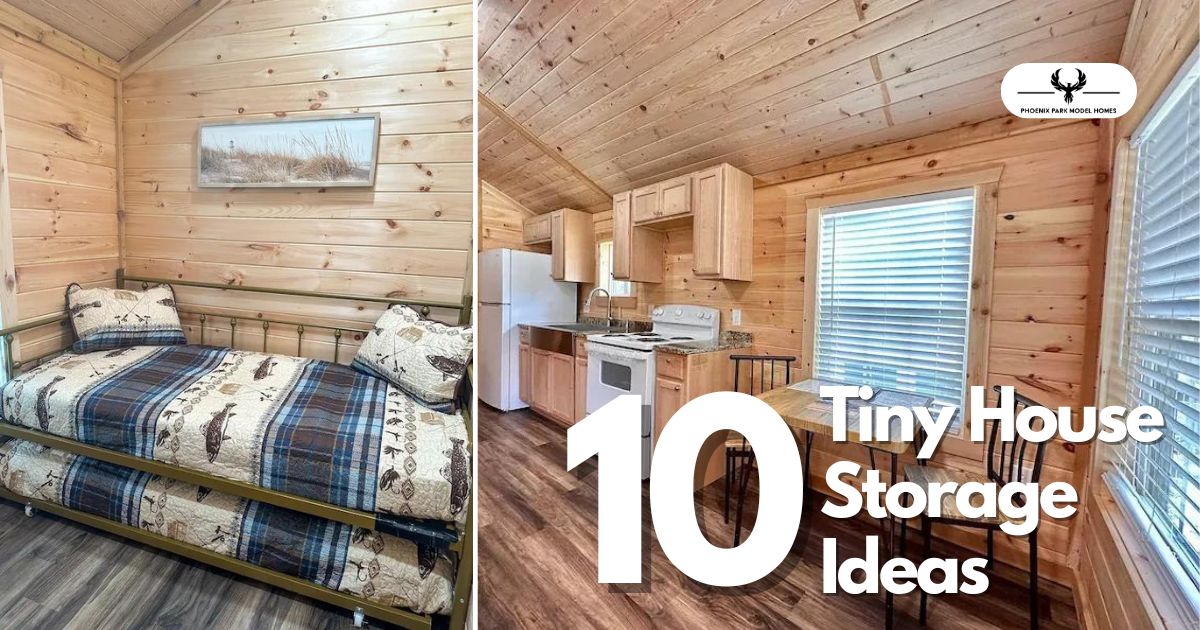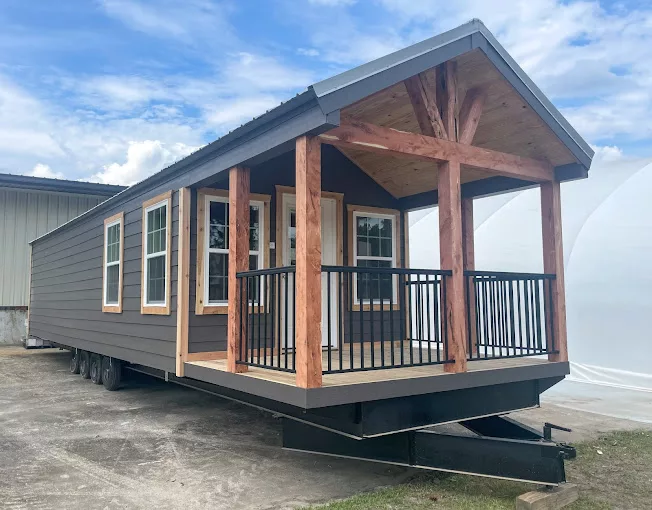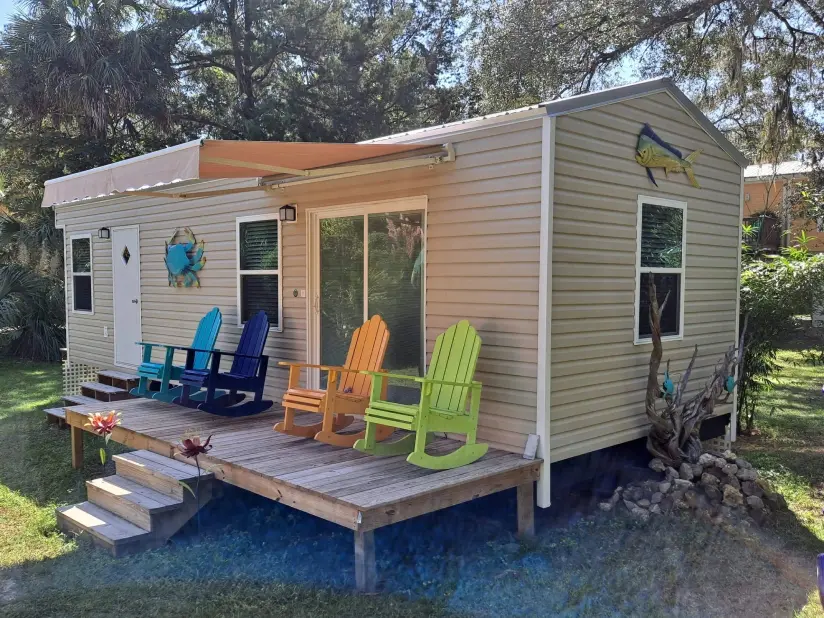Welcome to the world of park model homes where the charm of a vacation doorway meets the practicality of modern living. They are not just dwellings but the gateways to endless adventures and a chance to relish the beauty of diverse landscapes.
These beautifully crafted dwellings redefine the concept of compact living, offering a perfect blend of functionality and elegance. park model homes are a testament to innovation in architecture through their ingenious design features, precisely curated to optimize space without compromising on comfort.
Let’s embark on a journey into the world of park model homes where innovation, comfort, and nature converge to redefine the meaning of home.
What is a Park Model Home?
Park model homes, otherwise known as Recreational Park Trailers are built on a single frame mounted on wheels. They are built in compliance with ANSI A119.5 code, of an enclosed area not exceeding more than 400 sq. ft.
The RVIA (Recreational Vehicle Industry Association) defines park model homes as unique camper-type RVs designed to provide temporary accommodation for recreation, camping, or seasonal use.
These park model homes are transportable and parked at a destination where an RV is allowed. Then, necessary utilities are connected to operate homely fixtures and other appliances.
Our park model homes wear a blue & gold RVIA seal on the home’s exterior, which certifies we comply with the requirements of quality standards.

What are the specifications of park model homes?
In the United States, Park model homes must be designed in compliance with ANSI (American National Standards Institute) housing Standards. The Standards demand that an RV remain under 400 sq. ft and have steel tie-down straps for anchoring to the ground. These primary necessities are required to satisfy local county/park model home regulations.
The RVIA (Recreation Vehicle Industry Association) conducts a Safety Standard Inspection Program that demands member manufacturers of all RVs to possess the RVIA Standards Program Seal for every unit they manufacture in their factories.
The Seal indicates the certification that the unit complies with all the Standard requirements. A park model RV is usually identified by the blue and gold RVIA ANSI A119.5 certification seal or its forbearing green RPTIA seal fixed to the right of the unit’s main door.
What is the difference between a Modular Home, a Tiny Home, and a Park Model?
Here’s a comparative table highlighting the distinct characteristics and intended purposes of Modular homes, park models, and tiny homes catering to different lifestyles, needs, and regulatory frameworks.
| Aspect | Modular Homes | Park Model Homes | Tiny Homes |
| Size & Mobility | Typically larger and not easily movable | Compact and designed for mobility | Varied sizes; some portable, some fixed |
| Construction | Built to local building codes | Built to ANSI RV standards | Diverse construction styles and codes |
| Transportation | Requires specialized transportation and assembly on-site | Can be easily transported and set up in various locations | Can be movable or fixed on-site |
| Design & Customization | Customizable floor plans and designs | Limited customization due to size and mobility considerations | Often highly customizable to individual preferences |
| Permanent Vs Temporary | Often permanent structures | Intended for temporary or seasonal use | Can be permanent or portable, depending on design |
| Regulations | Subject to traditional housing regulations | Governed by RV and camping regulations | Varies widely based on size and location |
| Utilities | Connected to standard utilities like water, electricity, and sewage | May rely on RV-style hookups or off-grid solutions | Flexible utility options, some off-grid capability |
| Purpose | Often used as permanent residences | Primarily used as vacation homes or temporary living spaces | Versatile – used as primary homes, vacation homes, or rentals |
What is the difference between a Park Model and an RV?
Both park model homes and RVs are built to ANSI standards and own ANSI A119.5 code. Both require the same registration standards, tags, and insurance according to your state exigencies.
The significant discrepancy between them is their usage. Park model homes are manufactured for longer-term situations, such as campgrounds or other vacation locations, while RVs are designed to be mobile and moved regularly.
What is the standard size of a Park Model?
According to legal frameworks, an average park model home can be 12 ft wide and 33 ft long, with an area not exceeding 400 sq. ft. (excluding lofts and porches).
Apart from the square footage of living space, the length and width of a park model home must be in accordance with the transportation standards while moving your park model.
How much do park model homes cost?
A Used Park model can be as cheap as $25000 whereas a luxury one goes up to $220000.
- Phoenix Double take – Starts from $43,000
- Classic Series Park Models – Starts from – $50,950
- Classic Deluxe Series Park Models – Starts from – $60,950
- Full House series Park Models – Starts from – $68,050
- Full House 2 Park models – Starts from $64,950
Related: Park Model Homes Prices
Are Park Model Homes Movable?
As park model homes are built on a chassis with wheels, they are easy to move. A park model can be driven by simply detaching the skirting around them, disconnecting all the utilities, and joining aboard your transport vehicle.
An RV is designed in such a way to be used both as a home and a form of transportation by today’s digital rovers. However, the park model can be used only as a living space if parked. Moreover, transporting a park model home requires permits and oversized load escorts and can only be done by a professional.
Are Park Model Homes HUD-certified?
As Park model homes are designed in compliance and should adopt the standards with the American National Standards Institute (ANSI A119.5) for Park Model Recreational Vehicles (PMRV), they are excluded from the HUD’s standards of manufactured homes at 24 CFR 3282.8 (g).
However, park model homes over 400 sq. ft. and less than 500 sq. feet are often called HUD Park Model Homes. These park models are approved only for the state of Florida, which is built under the Housing and Urban Development Standard.
How Long Can You Live in a Park Model?
Park model homes are designed as temporary living spaces such as vacation homes, camping cabins, or hunting lodges. Mostly, park models are best to use for a few months at a time.
Legally speaking, many local and state governments need more specific regulations for park-model homes. Placing your park models in a campground or a mobile home park is preferable. Moreover, check with your local county regulations for parking your park models.
Prominent Uses of Park Model Homes
Whether you’re a vacationer seeking a retreat or a homeowner looking to expand your property’s functionality, Park model homes shine in their adaptability, catering to diverse needs. The versatility of park models makes them a valuable asset across various housing and accommodation scenarios.
1. Campgrounds
Park model homes are ideal for settlements within campgrounds, offering visitors a comfortable and convenient stay amidst nature. These homes are far beyond traditional tents or RVs, offering more amenities and space while enjoying the camping experience.
2. Vacation Getaway Cabins
Park model homes are perfect for those seeking a serene escape from stressful routines. Being placed in scenic locations like mountains, lakesides, or forests, they offer a cozy ambiance to relax, unwind, and enjoy nature’s beauty without compromising the modern lifestyle.
3. Airbnb
Park model homes are gaining popularity as Airbnb rentals. Their compact yet well-designed structures help travelers seek unique and comfortable accommodations. They offer park model owners to generate income by providing guests with a charming, self-contained living space that stands out from traditional rentals.
4. Temporary Housing
Park model homes serve as excellent temporary accommodation during transitional phases or while awaiting permanent housing. Whether you’re relocating, renovating, or any such circumstances, these homes offer a comfortable living space without a long-term lease commitment.
5. Accessory Dwelling Units(ADUs)
Park model homes are excellent ADUs, offering additional living space on a property without extensive construction. They serve as quarters while complementing the primary residence. ADUs can be a dwelling for family members, serve as home offices, or be rented out for supplemental income.
Is Financing Available for Park Model Homes?
Park model homes are classified as recreational vehicles, so they are not qualified for typical home financing options. However, you can apply for a personal loan or RV loan through your local bank or credit union.
Do Park Model Homes Maintain Their Value Over Time?
Park model homes can hold value well over time due to their durability, adaptability for various uses, and increasing popularity. They often retain their appeal and value with lower maintenance costs and market flexibility. However, factors like location and maintenance can influence their long-term value.
What could be the Potential Lifespan of a Park Model Home?
Usually, the lifespan of a park model home ranges between 30 and 50 years with minimum maintenance. However, the longevity of your park model home depends on the location where you parked your park model, wear and tear, and quality of maintenance. With minimum care, your park model will last for quite a long time.
Park Model Homes Available for Purchase
Various Park Models Available at Phoenix
1. Classic Series
The dimensions of Classic series park model homes are 11’7”x34’. The classic series comes with a standard appeal with your choice of two-tone vinyl exterior, wood grain vinyl flooring, pre-coated vinyl drywall interior, and 29 G Galvalume roof. Additional upgrade options include sliding entry doors and built-in bunk beds.
2. Classic Deluxe Series
The dimensions of Classic Deluxe Park model homes are 11’7”x34’ (enclosed) and 11’7”x43’ (porch included). This model offers you an 8-foot front porch with a railing so you can enjoy the outdoors!
This park model comes with options for exterior fiber cement “Hardie”, two-tone vinyl, or lapped wood. Interior options include tongue/groove wood, pre-coated vinyl drywall, and/or shiplap accent walls. This home includes a 29 G metal roof.
3. Full House Series
The dimensions of Full-house park model homes are 13’7”x29’ (enclosed) and 13’7”x39’ (porch included). This model offers you 2 bedrooms and 1 bathroom plus a 10-foot front porch with a railing so you can have ample space to enjoy the outdoors!
This park model comes with options for exterior fiber cement “Hardie”, two-tone vinyl, or lapped wood. Interior options include tongue/groove wood, pre-coated vinyl drywall, and/or shiplap accent walls. This home includes a 29 G metal roof.
4. Full House Series 2
The dimensions of the Full House series 2 park models are 13’7”x29’ (enclosed) and 13’7”x39’ (porch included).This model offers you 2 bedrooms and 1 bathroom plus a 10-foot front porch with a railing so you can have ample space to enjoy the outdoors!
This park model comes with options for exterior fiber cement “Hardie”, two-tone vinyl, or lapped wood. Interior options include tongue/groove wood, pre-coated vinyl drywall, and/or shiplap accent walls. This home includes a 29 G metal roof
Conclusion
Still, have questions regarding Park Model Homes, or are confused about which type to buy? Whether you are a camper looking for a permanent camping solution or a vacationer looking for rentals, park model homes are the perfect ones to choose from.
Contact us for more information or inquiries regarding the park model homes.













